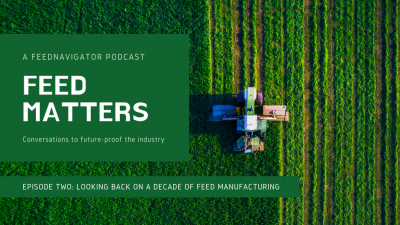Reports from IPPE
Despite feed mill consolidation, global feed production rises

Overall production was about 1.032bn metric tons, up from 995.6m metric tons in 2016, the company reported. Since 2012 there has been an average of 1.6% growth every year.
Alltech also estimated the value of the feed industry, globally, is about $469bn.
The Kentucky-based company has tracked feed production globally for the last six years. However, this year’s data is the most robust, said Aiden Connolly, chief innovation officer at Alltech, when we caught up with him last week at IPPE.
We asked about the implications of the findings, and more.
“It’s actually very difficult to collect information – it’s a moving target,” he said. “If I go to a feed mill today that’s making a thousand tons in a day, tomorrow it might make 800 tons, and the next day it might make 950, so how do you actually know what the number is when every number within the system is changing?”
However, the “robustness” of the report has improved with increasing years of data collected that can be used as reference, he said.
In addition to the overall rise in global production, this year’s report also captured several trends such as growth in production for Africa, feed mill consolidation and Alltech saw an expansion for aquaculture feed production.
“There was no guarantee that we would have broken the billion-ton mark, but Africa is up very strongly, aquaculture is growing strongly, Latin America continues to grow and there are many star countries in Southeast Asia,” he said. “There was enough there to carry it across the line.”
Feed and the economy
“The canary looks very healthy,” Connolly said of how the feed industry relates to the economy. “I think the world economy looks in good shape, and we’re clearly moving toward some higher value meats.”
Countries like Vietnam and several African countries are showing positive trends, he said.
The Brazilian picture is slightly more complicated as the feed industry is up, even though the country is facing some economic challenges, he said. “That indicates that agriculture is still very strong in Brazil and it’s continued to grow in terms of exports to other countries,” he added.
Additionally, the aquaculture sector is continuing to grow at about 8% and fish feed production is keeping pace, said Connolly. “It’s an exciting area to look at certainly, aquaculture,” he added.
There are some challenges facing the expansion of aquaculture like fish being mislabeled for sale and the need for fishmeal alternatives, he said. “We’ve got some big issues, but the long-term trends toward consuming more fish, and the fact that more fish come from farms than the sea, have all got to be good for the feed industry,” he added.
Global production
Globally, 30 countries account for 82% of the feed mills and generate about 86% of the feed produced annually, said Alltech. It takes another 111 countries to account for the last 14% of production.
Ten 10 countries, including China, the US, Mexico, Spain, Germany, India, France, Russia, Japan and Brazil, are responsible for 56% of the feed mills in production and 60% of the feed manufactured, the company said. However, together China and the US can account for about one-third of feed produced.
The US generated about 169.69m metric tons in 2016 and the North American region came in third for overall production at 191.1m, the company said.
The expectation is that production will continue to grow even if it slows slightly at a global level, said Connolly. “The 3.4% that we saw this year maybe was a little larger than normal, but long term I’d still say 2% growth globally will be the norm,” he added.
That growth is fueled by interest in the production of animal proteins, he said.
“You can assume that people who have eaten meat are not going to go back to eating rice and beans,” he said. “Once they’ve got the taste for it, they may eat less, they may not grow that much, but I don’t think we’re going to see people go back to being vegetarians or vegans.”
Regionally, Asia has the largest overall feed production and China remains the world’s largest feed producer, the company said. However, several countries in that area including Vietnam, Pakistan, India and Japan also saw increased production.
Additionally, several African countries have increased their feed manufacture from 2015 to 2016, said the company. Overall, the continent saw a 13% increase in feed production, while several individual countries like Nigeria, Algeria, Tunisia, Kenya and Zambia saw growth of about 30%.
“Countries that are growing tend to continue growing,” said Connolly. “If the Nigerian population goes to 500m by 2050, which everybody says it will and it becomes the third largest country in the world, then Nigeria’s feed production, which is very underdeveloped, will have to grow tremendously to be anywhere comparable to countries with a similar population.”
Several European countries actually saw a decline in feed production from 2015 to 2016, said Alltech. These included Germany, France, the Netherlands and Turkey. However, Spain had an 8% increase in feed generation.
Brazil continues to be the largest feed producer in Latin America, the company said. However, Mexico saw an increase in the amount of feed it produced and is nearing half Brazil’s production ability.
Mill consolidation
Much of feed mill consolidation has to do with developments in Asia, said Connolly. “China is going through massive changes,” he added.
“The primary driver is Chinese government policy to reduce food safety risks,” he said. “They’re very concerned that these smaller mills are the ones that have all these antibiotic issues – they’ve reduced the number of antibiotics that can be fed through feed to a list of 35.”
With the increased concern regarding antibiotic use and food safety, the administration increasingly wants to survey feed mill production, he said. “They can only do so if they’ve got a smaller number – the number we estimate is down to about 6,000 feed mills and it was 12,000 a few years ago,” he added.












